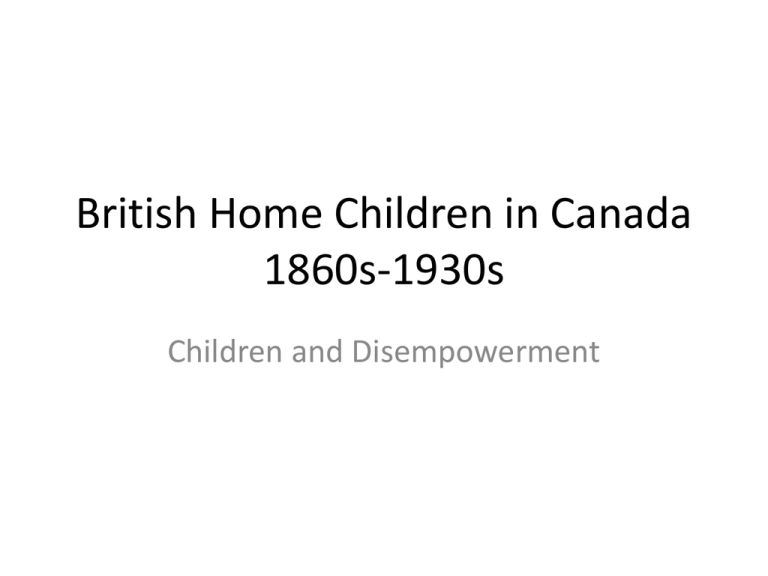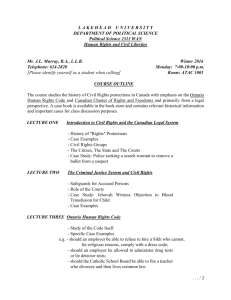Home Children
advertisement

British Home Children in Canada 1860s-1930s Children and Disempowerment Home Children • Between 1869 and the late 1930s, over 100,000 juvenile migrants were sent to Canada from Great Britain during the child emigration movement. Motivated by social and economic forces, churches and philanthropic organizations sent orphaned, abandoned and pauper children to Canada. • Most of these children had been brought up in poverty, and were homeless or living in the urban slums of Britain. Some were accused or even convicted of petty crimes. Many were orphans, while others were simply the victims of poverty, illness and misfortune. These children were typically placed in orphanages or workhouses by parents or kin who could not afford to take care of them. • Many believed that these children would have a better chance for a healthy, moral life in rural Canada, where families welcomed them as a source of cheap farm labour and domestic help. • The intent of the juvenile immigration program was to place these children with good Canadian families and thus increase their chances of leading happy and prosperous lives; but not all of the stories were happy ones. • The ideal lives of these children, the younger ones in particular, were to be adopted into families ; however, this was often not the case. • Most home children simply served as indentured servants. Many of them ate and slept apart from the families and were treated as paid help. • In addition, the contract stipulated that if the family was unhappy with the performance or behaviour of a child, they could return him or her to the distribution home. As a result, many children, particularly teenagers, were placed with a number of different families. • After arriving by ship, the children were sent to distributing homes, such as Fairknowe in Brockville, and then sent on to farmers in the area. • Although many of the children were poorly treated and abused, others experienced a better life here than if they had remained in the urban slums of England. Many served with the Canadian and British Forces during both World Wars. British immigrant children from Dr. Barnardo's Homes at landing stage, Saint John, N.B. A boy ploughing at Dr. Barnardo's Industrial Farm, Russell, Manitoba, ca. 1900 Immigrant girls on their way to the Stratford Home in Ontario, 1908. Immigrant boys on their way to the St. George Home in Ontario, 1908 Mistreatment of Home Children One of the most famous cases was that of George Everett Green, a 15-year-old boy who, in 1895, died of neglect, starvation and abuse. His caregiver, Helen Findlay, was charged with murder but was never convicted, as the jury was unable to agree on a verdict. The story of Everett Greene prompted the public to question the juvenile immigration scheme. HOME CHILDREN ASSIGNMENT • It is 1909 and you were sent from your homeland in Britain to a new life in Canada over a year ago. Write a detailed journal entry about your experiences as a Home Child (use details mentioned in the book or presentation). • It is 1895 and young George Everett Green, a home child in Ontario, has died of neglect and starvation. You are a reporter with the “Great Canadian” Post; the death of the home child and the murder trial of his caregiver have sparked Canadian interest in home children so your editor has sent you out to interview some of these children and record their experiences. Write a fictional interview of a home child using details mentioned in the book and presentation.











